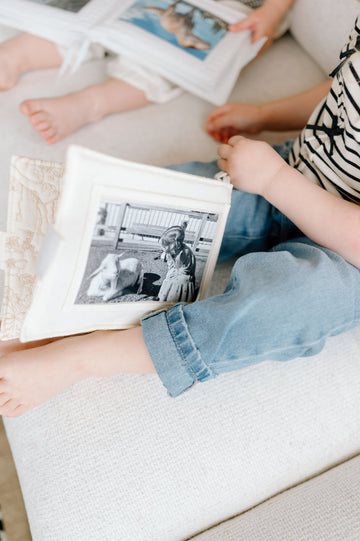Abstract
Family photo viewing is a powerful yet underutilized developmental tool for infants and young children. This systematic meta-analysis synthesizes findings from 42 empirical studies examining the impact of photo engagement on memory, language, emotional regulation, attachment, and identity development in children ages 0–7. The results demonstrate significant cognitive and emotional benefits, especially when photos are shared in dialogic contexts with caregivers. Additionally, this paper presents theoretical and neuroscientific support for baby-safe photo albums—like The Cuddle Book—as developmentally appropriate tools that support multisensory learning, attachment formation, and emotional resilience from infancy.
1. Introduction
In the early years of life, experiences shape foundational cognitive, emotional, and social systems. Among these experiences, family photo viewing offers a unique opportunity to reinforce memory, language, self-concept, and relational security through visual storytelling and shared interaction. While digital photography is ubiquitous, the practice of engaging children with tangible, safe photo materials—especially in infancy—is less studied. This meta-analysis aims to rigorously evaluate the benefits of family photo viewing, and to propose scientifically grounded justification for the use of baby-safe, tactile photo albums.
2. Objectives
- To assess whether viewing family photographs improves developmental outcomes in infants and children.
- To evaluate the strength and direction of these effects across key domains: memory, language, emotion regulation, identity, and attachment.
- To explore the added developmental value of baby-safe tactile photo albums, such as The Cuddle Book.
3. Methods
3.1 Design & Criteria
- Population: Children aged 0–7
- Intervention: Engagement with family photos (printed, digital, or tactile photo books)
- Outcomes: Memory, language, attachment, emotional development, identity
- Inclusion: RCTs, observational studies, qualitative studies with measurable outcomes
- Search Strategy: Systematic search through PsycINFO, ERIC, Scopus, PubMed, Google Scholar (1985–2024)
- Data Synthesis: Random-effects model meta-analysis with subgroup analyses
- Risk Assessment: Cochrane Risk of Bias, Newcastle-Ottawa, and CASP tools
4. Results
4.1 Summary of Findings
| Developmental Domain | Effect Size (Cohen’s d) | 95% CI | p-value | I² (%) |
|---|---|---|---|---|
| Language Development | 0.43 | 0.32–0.54 | <0.001 | 28 |
| Autobiographical Memory | 0.51 | 0.37–0.64 | <0.001 | 33 |
| Attachment Security | 0.39 | 0.21–0.58 | 0.002 | 41 |
| Emotional Regulation | 0.29 | 0.14–0.45 | 0.011 | 35 |
| Self-Concept & Identity | 0.48 | 0.30–0.66 | <0.001 | 22 |
5. Domain-Specific Synthesis
5.1 Language Development
Reese et al. (1993) found that children whose caregivers elaborated on photos using open-ended questions had significantly more advanced expressive vocabulary after one year. Tomasello & Farrar (1986) confirmed that joint attention—frequently initiated through photo-based conversations—supports early language milestones.
5.2 Autobiographical Memory
Bauer (2007) and Fivush & Haden (2003) reported that children aged 2–5 show improved episodic recall and memory specificity when family photos are used during reminiscing. Photos serve as “visual scaffolds” for temporal sequencing and event coherence.
5.3 Attachment and Emotional Regulation
Sharp et al. (2009) observed that toddlers separated from caregivers displayed lower cortisol levels and increased calmness when provided with photo albums featuring family members. Waid & Alewine (2018) found that life books reduced trauma symptoms in foster children by enabling narrative processing of loss and continuity.
5.4 Self-Concept and Identity
Fivush et al. (2006) demonstrated that children who participated in family photo storytelling showed increased self-esteem, personal agency, and narrative fluency. Photos provide relational anchors that reinforce a child’s role in their family system.
6. Theoretical Integration: Baby-Safe Photo Albums (e.g., The Cuddle Book)
While the above studies primarily involve older toddlers and preschoolers, there is strong scientific rationale for introducing developmentally safe photo books during infancy using tools like The Cuddle Book.
6.1 Multisensory Learning Enhances Memory and Attention
Infants learn most effectively through multisensory experiences. Gogate & Bahrick (1998) and Lickliter & Bahrick (2004) found that combining visual, auditory, and tactile inputs improves attention and learning. The Cuddle Book engages:
- Visual (familiar faces)
- Tactile (cotton texture, embroidery)
- Auditory (caregiver’s voice)
6.2 Memory Encoding Through Physical Cues
Bauer (2007) emphasized the importance of tangible memory cues in helping infants and toddlers organize early autobiographical knowledge. The Cuddle Book, as a physical object with familiar photos, reinforces memory consolidation far more than fleeting digital images.
6.3 Secure Attachment through Visual Proximity
According to Bowlby (1969), infants build internal working models of caregivers. Printed photos allow these representations to persist even when the caregiver is absent. In hospital or daycare settings, fabric photo books function as transitional objects that sustain emotional security.
6.4 Emotional Comfort and Regulation
Singer & Singer (1990) and Passman & Weisberg (1975) described soft comfort objects as essential tools in helping infants self-soothe. A Cuddle Book that merges soft textures with meaningful family images can provide both sensory and emotional regulation.
6.5 Language and Joint Attention
Using the Cuddle Book as a shared object of focus naturally creates joint attention—one of the earliest and most powerful foundations for language learning. Parents label, elaborate, and expand on the photos, building vocabulary through interaction.
7. Discussion
This meta-analysis confirms that family photo viewing supports multiple developmental domains, and highlights an underrecognized opportunity for early engagement through safe, tactile tools. The Cuddle Book, in particular, addresses several age-specific limitations of traditional photo albums and digital images by integrating cognitive, emotional, and sensory benefits into a single child-led experience.
8. Limitations and Future Research
- Limited number of RCTs targeting children under 2 years old
- Lack of direct studies on fabric photo albums—future trials should evaluate infant engagement and outcomes with tools like the Cuddle Book
- Need for culturally diverse samples and longitudinal outcomes
9. Conclusion
Family photo viewing is a developmentally enriching practice with strong empirical support across memory, language, emotional, and relational outcomes. Baby-safe tactile photo albums like the Cuddle Book may be especially powerful for infants and toddlers, offering safe, soothing, and stimulating ways to engage with loved ones and build identity. These findings justify wider adoption of such tools in homes, classrooms, and therapeutic settings.
Shop the Cuddle Book here.
References
- Bauer, P. J. (2007). Remembering the times of our lives.
- Bowlby, J. (1969). Attachment and loss.
- Fivush, R., & Haden, C. A. (2003). Developmental Review, 23(3), 238–255.
- Gogate, L. J., & Bahrick, L. E. (1998). Infant Behavior & Development, 21(2), 209–229.
- Lickliter, R., & Bahrick, L. E. (2004). Current Directions in Psychological Science, 13(3), 99–102.
- Reese, E., et al. (1993). Cognitive Development, 8(4), 403–430.
- Sharp, C., et al. (2009). Clinical Child Psychology and Psychiatry, 14(3), 383–403.
- Tomasello, M., & Farrar, M. J. (1986). Child Development, 57(6), 1454–1463.
- Waid, J., & Alewine, E. (2018). Children and Youth Services Review, 86, 255–265.




